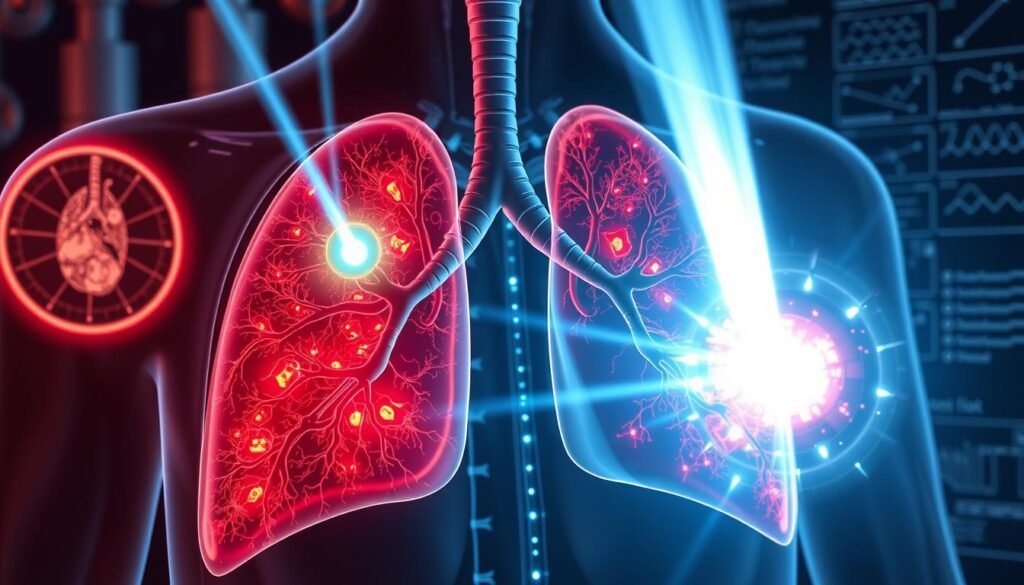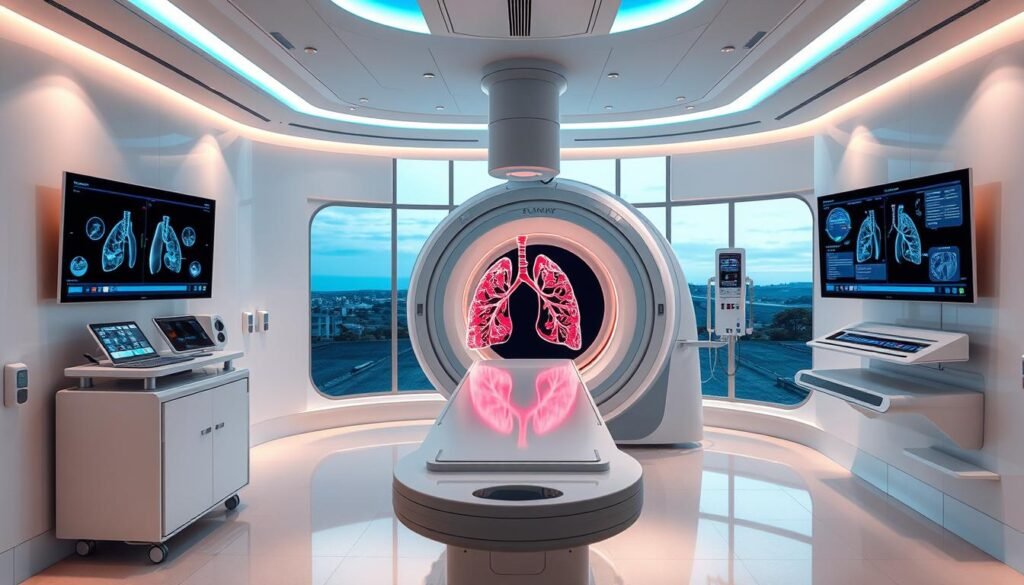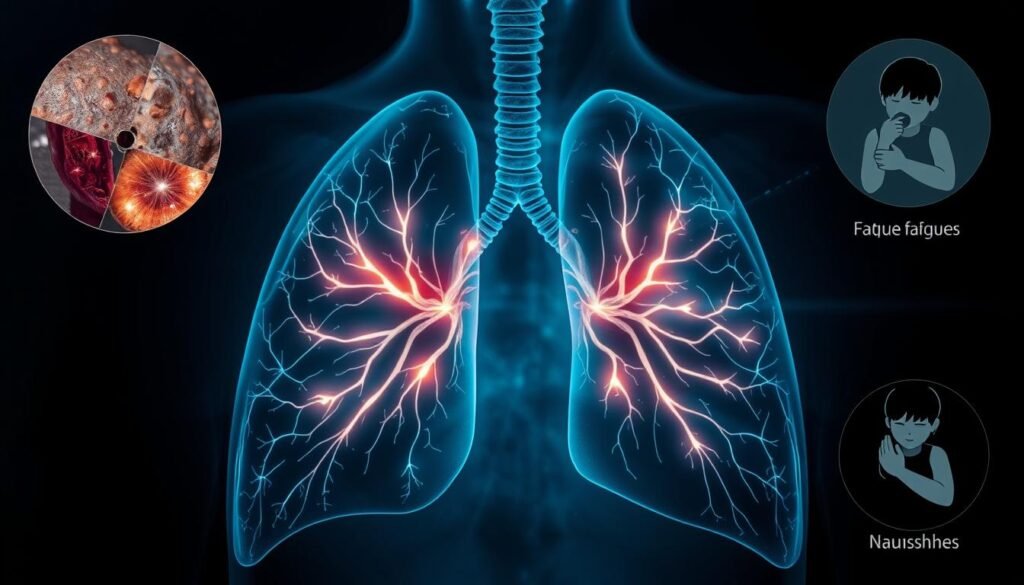Did you know external beam radiation therapy is the top treatment for lung cancer? It’s usually given about five times a week. This method uses high-energy rays to kill cancer cells. It plays a key role in battling this disease. Understanding the science behind radiation therapy is vital. This includes knowing its forms, side effects, and how recovery works.
This article explores the science behind radiation therapy for lung cancer. It explains how the therapy works, the plans for treatment, and possible side effects. Knowing how radiation oncology works helps patients make better decisions during their treatment.
Key Takeaways
- Radiation therapy is a primary treatment modality for lung cancer.
- Most side effects from radiation therapy improve within two months.
- Radiation therapy can be combined with treatments like surgery and chemotherapy.
- Check-ups may be required regularly post-treatment to monitor long-term effects.
- Brachytherapy and proton therapy are also effective options for targeted treatment.
Understanding Radiation Therapy
Radiation therapy is key in treating lung cancer. It uses high doses of radiation to kill cancer cells and shrink tumors. This therapy started in the 1890s and is constantly getting better.
What is Radiation Therapy?
Radiation therapy uses high-energy rays, like X-rays, to target cancer. There are two types: external beam radiation therapy and brachytherapy. External beam radiation comes from a machine and is used for tumors in places like the head or lung. Brachytherapy puts radioactive material right near or in the tumor. It’s used for prostate and breast cancers, among others.
How Radiation Works in Killing Cancer Cells
Radiation therapy works by damaging the DNA in cancer cells, stopping them from dividing. This can kill the cells. The goal is to only target the tumor, sparing healthy tissues. Thanks to new technology, treatments now better protect healthy cells and have improved patient outcomes.
About 50% of all cancer patients will need radiation therapy. The effects of radiation may show up long after treatment. This underlines the importance of ongoing care. With cancer cases expected to reach 26 million a year by 2030, knowing about radiation therapy is crucial for both patients and doctors.
| Type of Radiation Therapy | Application | Common Uses |
|---|---|---|
| External Beam Radiation Therapy | Delivers radiation from a machine | Head, neck, breast, lung, colon cancers |
| Brachytherapy | Involves putting radioactive materials inside or near the tumor | Prostate, breast, skin, head, and neck cancers |
The Science Behind Radiation Therapy for Lung Cancer
Radiation therapy is a key player in lung cancer treatment. Its mechanism of action zeros in on cancer cells to damage them. Radiobiology shapes treatment to fit every patient’s specific needs.
Mechanism of Action: How Radiation Affects Tumors
Radiation therapy’s main aim is to mess up the DNA in cancer cells. High-energy rays are used for this purpose. They try to stop cells from multiplying by causing irreversible harm. This often triggers apoptosis, or cell death, which slows down tumor growth. Radiation is regularly combined with other treatments to boost success. Studies show that mixing radiation with certain drugs can work better for some cancers. Yet, this combo might make side effects worse.
The Role of Radiobiology in Treatment Planning
Radiobiology is crucial for crafting effective treatment plans. It helps understand how lung cancer reacts to different radiation levels. Things like the cancer’s size, place, and stage are vital for the best treatment approach. Proper planning uses simulations and imaging for accurate radiation targeting. This helps protect healthy tissue nearby. Over half of cancer patients are treated with radiation, which underscores its role in fighting cancer. For more details on how radiation therapy works, check out this article.

| Factor | Impact on Treatment |
|---|---|
| Tumor Type | Determines radiation sensitivity and treatment approach |
| Tumor Size | Affects dosage and radiation technique selection |
| Tumor Location | Informs precision targeting to preserve healthy tissue |
| Patient Health | Influences overall treatment strategy and safety considerations |
Types of Radiation Therapy Used for Lung Cancer
Lung cancer treatment uses different kinds of radiation therapy. These treatments are made for each patient’s needs. Knowing the treatments well can really help the patient get better and enjoy life more.
External Beam Radiation Therapy
External beam radiation therapy (EBRT) is mostly used to treat lung cancer. It sends energy beams from a machine to the tumor. It works really well for a type of lung cancer called non-small cell lung cancer (NSCLC).
EBRT has types like 3D-CRT and IMRT. They aim the beams very carefully at the cancer. This means the healthy parts around it don’t get hurt. These methods are good because they tailor the treatment using detailed pictures.
Brachytherapy: Internal Radiation Treatments
Brachytherapy is different because it puts radioactive stuff right at or near the tumor. It’s great since it targets the cancer closely. This way, the parts around it stay safe. This method is a top choice for lung cancers that haven’t spread. It works well and is gentle on the body.
Proton Therapy and Its Advantages
Proton therapy uses protons, a change from the usual X-rays. The big plus is how precisely it targets tumors. This matters a lot for lung cancer near important places like the heart. By protecting healthy parts, proton therapy could not only work better but also help patients feel better during treatment.
| Type of Radiation Therapy | Description | Ideal Use |
|---|---|---|
| External Beam Radiation Therapy (EBRT) | High-energy beams directed at cancer from outside the body. | Most commonly used for NSCLC, especially advanced stages. |
| Brachytherapy | Radioactive materials placed internally near the tumor. | Localized tumors for targeted treatment. |
| Proton Therapy | Uses protons to target cancer with high precision. | Advanced lung cancers located near critical organs. |
Techniques in Radiation Oncology
Advancements in radiation oncology have greatly improved treatments for lung cancer. Image-guided radiation therapy and stereotactic body radiation therapy are two stand-out techniques. They focus on targeting the tumor accurately while protecting healthy tissues.
Image-Guided Radiation Therapy (IGRT)
Image-guided radiation therapy uses advanced imaging for better accuracy. It lets doctors adjust the radiation in real-time, considering tumor movements and the lung’s mobility. IGRT ensures the best treatment delivery, thus improving outcomes.
Stereotactic Body Radiation Therapy (SBRT) Explained
Stereotactic body radiation therapy is ideal for patients with small lung tumors. It involves high-dose radiation over one to five sessions. SBRT precisely targets the tumor while sparing healthy tissue. Studies show SBRT has about a 70% cure rate for early-stage lung cancer.

| Technique | Benefits | Frequency | Cure Rate |
|---|---|---|---|
| Image-Guided Radiation Therapy (IGRT) | Real-time tracking and adjustments for accuracy | As needed during treatment sessions | Varies based on specific conditions |
| Stereotactic Body Radiation Therapy (SBRT) | High-dose treatment in fewer sessions | 1 to 5 sessions | Around 70% for early-stage lung cancer |
These techniques also improve the patient experience in lung cancer treatment. With technology advancing, we expect even more precision in the future. This will likely lead to better survival rates. For more insights, read this comprehensive article here.
Determining the Treatment Plan
Tumor evaluation is key for a good lung cancer treatment plan. The team looks at the tumor’s size and where it’s located. They use this info to pick the best radiation therapy option. This careful check is vital for choosing the right dose and how to give it. It helps the treatment work well and lowers risks.
Evaluating Tumor Size and Location
To plan the lung cancer treatment, knowing the tumor’s size and spot is critical. 18F-FDG-PET/CT scans are very helpful for this. They make sure the team knows the tumor really well, which helps with planning high-dose radiotherapy. This better understanding leads to a plan that’s more focused and personal. It aims to kill the cancer cells in the best way.
Team Collaboration in Developing a Treatment Strategy
Building a good treatment plan needs teamwork. This team includes radiation oncologists, medical physicists, and nurses. They all focus on care for the patient. By working together, they create a treatment that looks at all parts of the patient’s health and what they want. This teamwork usually means better results.
Side Effects of Radiation Therapy
Radiation therapy for lung cancer works well, controlling tumors in about 95% of cases for three years. This treatment can lead to different side effects. This is because of the therapy’s nature and the patient’s health. Knowing about these side effects helps patients and doctors deal with them early.
Common Side Effects and Their Management
Short-term side effects can affect everyday life. They include:
- Fatigue
- Skin changes
- Nausea
- Loss of appetite
- Coughing
- Shortness of breath
It’s vital to manage these side effects to keep a good quality of life. There are ways to help, like medicine for nausea, skin care tips, and advice on food to help with lost appetite. Patients should talk often with their doctors to deal with symptoms better.
Long-Term Effects and Follow-Up Care
Long-term effects might show up after treatment ends. These can include:
- Permanently damaged lungs resulting in ongoing shortness of breath
- Long-term coughing
- Headaches and confusion if the brain is affected
- Potential heart complications
Regular check-ups are vital to look after your health after treatment. This care helps doctors catch and treat any problems early. While many side effects get better within months, it’s important to keep an eye on delayed effects. This ensures patients get continuous help and support.

Preparing for Radiation Therapy
Getting ready for radiation therapy is very important for patients. It helps to know what’s coming, which lowers worry and gives them control. Before anything starts, there’s a CT Simulation that goes for 1 to 3 hours. The first treatment is set about 1 to 2 weeks after. This time is used to make a very exact plan.
What to Expect Before Treatment Begins
The simulation session is careful to position patients right. This ensures the radiation hits the right spots. It may take 10 to 14 days to finish this step. Then, it’s time for treatment.
Expect each session to last 15 to 30 minutes. But, the actual radiation takes less than 5 minutes. Patients will see their doctor weekly to check on progress and ask questions.
Essential Tips for Patients
To handle treatment expectations well, patients should:
- Eat well to keep up health.
- Sleep enough for healing.
- Talk openly with doctors for better support.
- Know that side effects usually get better with time.
- Try to keep life normal after treatment.
After finishing radiation therapy, taking care of the skin is key. There will also be regular checkups and maybe some tests. Staying educated on their treatment can help patients manage their health better.
Post-Treatment Care and Recovery
After lung cancer radiation treatment, focusing on post-treatment care is key. This care ensures a smoother recovery. Patients should have regular check-ups to see how well the treatment worked and to handle any side effects.
Monitoring Progress After Radiation Therapy
Recovery monitoring means going to the doctor often. At first, these visits are every few months. Later, they become yearly. These check-ups help see how well you’re recovering and catch any problems early.
Doctors also check how your heart and esophagus are doing, especially after certain treatments like proton therapy. This is a crucial part of supporting the patient during recovery.
Support Resources for Patients and Families
Support for patients and their families is very important after treatment. Many groups provide help and information for cancer survivors. Being part of a support group gives a feeling of community. This is very good for mental health and well-being.
It’s important for patients to use these resources. They help make life better as patients move from treatment to recovery. Engaging with support groups can really make a difference.
Conclusion
Radiation therapy is key in treating lung cancer. It focuses on tumors while keeping healthy tissues safe. New techniques like intensity-modulated radiation therapy and stereotactic body radiation therapy help patients. They lead to better results and a higher quality of life. Studies show that lung cancer patients getting radiotherapy have longer survival rates than those choosing just surgery.
It’s crucial to understand treatment plans, side effects, and the need for support. Patients and their families must know about lung cancer treatments. They should work closely with their healthcare teams. The success of radiation therapy depends on the technique and teamwork among doctors.
To learn more, you can read a detailed summary of radiation therapy techniques. The area of radiation oncology is improving. Continuous research and better care plans will help those with lung cancer live longer, better lives.